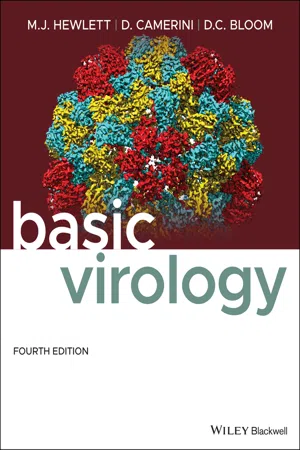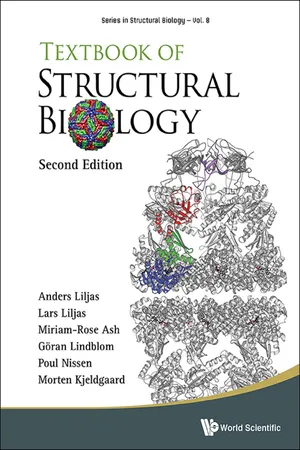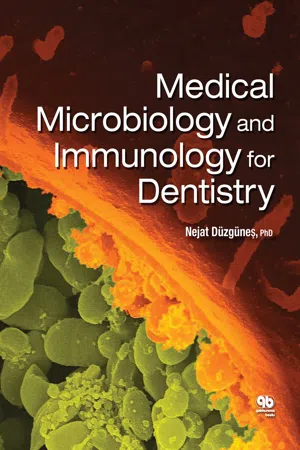Biological Sciences
Viral Capsid
A viral capsid is a protein shell that encloses the genetic material of a virus. It provides protection for the viral genome and helps in the process of infecting host cells. The capsid plays a crucial role in the virus's ability to survive outside a host and to initiate infection.
Written by Perlego with AI-assistance
Related key terms
9 Key excerpts on "Viral Capsid"
- eBook - ePub
- Martinez J. Hewlett, David Camerini, David C. Bloom(Authors)
- 2021(Publication Date)
- Wiley-Blackwell(Publisher)
The capsid functions to provide a protein shell in which the chemically labile viral genome can be maintained in a stable environment. The association of capsids with genomes is a complex process, but it must result in an energetically stable structure. While viruses can assume a range of shapes, some quite complex, given the dimensions of virus structure and the constraints of the capsomer's structural parameters, a very large number assume one of two regular shapes. The first is the helix, in which the capsomers associate with helical nucleic acid as a nucleoprotein – these can be either stiff or flexible depending upon the properties of the capsid proteins themselves. The other highly regular shape is the icosahedron, in which the capsomers form a regular solid structure enfolding the viral genome. Despite the frequency of such regular shapes, many viruses have more complex and/or less regular appearances; these include spindle, kidney, lemon, and lozenge shapes. Further, some viruses can assume different shapes depending upon the nature of the cells in which they mature, and some groups of viruses – notably the poxviruses – are distinguished by having a number of different shapes characterizing specific members of the group. Arrangement of the capsid around its viral genetic material is unique for each type of virus. The general properties of this arrangement define the shape of the capsid and its symmetry, and since each type of virus has a unique shape and structural arrangement based upon the precise nature of the capsids proteins and how they interact, capsid shape is a fundamental criterion in the classification of viruses. The technique of x‐ray crystallography has been applied fruitfully to the study of capsid structures of some smaller icosahedral viruses, and structural solutions for human rhinovirus, poliovirus, foot and mouth disease virus, and canine parvovirus are available - eBook - ePub
- Boriana Marintcheva(Author)
- 2017(Publication Date)
- Academic Press(Publisher)
nm in diameter, thus falling in the lower half of the size range relevant to nanotechnology. As great as this historic example is, it addresses a single application of Viral Capsids as an immunity-inducing entity and hints at only a couple of the reasons why Viral Capsids are extremely helpful for developing nanotechnologies: they are easy to produce and straightforward to destroy. Viral Capsids are much more versatile than that, and their utility has much to do with their biological nature, the many years of coevolution with their hosts, and extensive research on their properties and characteristics translating into a broad array of tools and options for modification. The current discussion will be limited to four major aspects of Viral Capsids’ value to nanotechnology: (1) accessibility, (2) biocompatibility, (3) ability to self-assemble, and (4) potential for modification.6.2.1. Viral Capsid Accessibility
Viruses are a very diverse and very abundant biological entity found essentially everywhere in nature. Most likely no one will ever know exactly how many different virus species or how many total viruses are on the planet, simply because those numbers are dynamic; however, it is easy to be relatively precise describing the number of viruses in nature as tremendous. It has been estimated that there are 1031 viruses on Earth, mostly bacteriophages. Furthermore, viruses have been isolated from very diverse environments in terms of pH, temperatures, salt concentration, pressure, etc. and are known to infect organisms from all kingdoms. Therefore, theoretically there is a huge pool of Viral Capsid types with different properties available to nanoscience. Naturally, current efforts are focused on the best-studied viruses and, understandably, the most useful ones are bacteriophages and plant viruses, which do not pose health risks to humans or economically significant animals (Fig. 6.1 ). Accessibility is also a function of our ability to produce large amounts of high-quality isomorphic particles in a reasonable time and at a reasonable cost. Virus nanoparticles (VNPs) are essentially Viral Capsids, which are produced “naturally” by allowing viruses to propagate in their hosts. VNPs have limited applications, unless they are modified/engineered to acquire special properties. Most frequently, VNPs are genetically engineered to express proteins/peptides of interest, which confer functionality or allow other molecules to be attached and do so. Virus-like particles (VLPs) are of better use since they lack the original viral genome and thus cannot be infectious. VNPs and VLPs of bacterial, animal, and plant viruses have been successfully produced in laboratory and commercial settings using various in vivo and in vitro approaches. VNPs are produced in their natural host, whereas VLPs are mainly produced in heterologous expression systems, most frequently E. coli , yeast, or plants. Insect or mammalian tissue culture expression systems are also viable options. For many viruses, empty capsids are by-products of the natural assembly process and can be isolated from infected cells in parallel with VNPs. If feasible, VLPs can also be produced from VNPs by removing their nucleic acids. The latter could be accomplished by pH-driven swelling of VNPs followed by alkaline hydrolysis, which essentially release and chemically destroy the viral nucleic acids. Alternatively, VNPs could be forced to disassemble to individual capsid proteins (CPs), the nucleic acids could be extracted, and the CPs reassembled into the VLP. For example, CCMV (cowpea chlorotic mottle virus infecting black-eyed pea/bean plants) capsid can be disassembled to CP dimers and RNA at pH 7.5 in the presence of calcium salt and assembled as an empty VLP at pH 5 (Fig. 6.2 - eBook - ePub
- Jane Flint, Vincent R. Racaniello, Glenn F. Rall, Theodora Hatziioannou, Anna Marie Skalka(Authors)
- 2020(Publication Date)
- ASM Press(Publisher)
4 Structure- Introduction
- Functions of the Virion
- Nomenclature
- Methods for Studying Virus Structure
- Building a Protective Coat
- Helical Structures
- Capsids with Icosahedral Symmetry
- Other Capsid Architectures
- Packaging the Nucleic Acid Genome
- Direct Contact of the Genome with a Protein Shell
- Packaging by Specialized Viral Proteins
- Packaging by Cellular Proteins
- Viruses with Envelopes
- Viral Envelope Components
- Simple Enveloped Viruses: Direct Contact of External Proteins with the Capsid or Nucleocapsid
- Enveloped Viruses with an Additional Protein Layer
- Large Viruses with Multiple Structural Elements
- Particles with Helical or Icosahedral Parts
- Alternative Architectures
- Other Components of Virions
- Enzymes
- Other Viral Proteins
- Cellular Macromolecules
- Mechanical Properties of Virus Particles
- Investigation of Mechanical Properties of Virus Particles
- Stabilization and Destabilization of Virus Particles
- Perspectives
- References
- Study Questions
LINKS FOR CHAPTER 4
- Video: Interview with Dr. Michael Rossmann http://bit.ly/Virology_Rossmann
- Movie 4.1: Virus-based piezoelectric generator http://bit.ly/Virology_piezo
- Movie 4.2: Cryo-EM reconstruction of the adenovirus type 5 capsid http://bit.ly/Virology_AD5Cap
- Sizing up adenovirus http://bit.ly/Virology_Twiv101
- The Big Picture Book of Viruses http://www.virology.net/Big_Virology/BVHomePage.html
- ViralZone http://viralzone.expasy.org/
- Viruses in the extreme http://bit.ly/Virology_5-28-15
- Virus particle explorer http://viperdb.scripps.edu/
In order to create something that functions properly—a container, a chair, a house—its essence has to be explored, for it should serve its purpose to perfection; i.e., it should fulfill its function practically and should be durable, inexpensive and beautiful.WALTER GROPIUSNeue Arbeiten der Bauhauswerkstätten, Bauhaus Book no. 7, 1925Introduction
Virus particles are elegant assemblies of viral, and occasionally cellular, macromolecules. They are marvelous examples of architecture on the molecular scale, with forms perfectly adapted to their functions. Virus particles come in many sizes and shapes (Fig. 4.1 ; also see Fig. 1.7 - eBook - ePub
- Anders Liljas, Lars Liljas;Miriam-Rose Ash;G?ran Lindblom;Poul Nissen;Morten Kjeldgaard(Authors)
- 2016(Publication Date)
- WSPC(Publisher)
18 Virus Structure and Function 18.1 Virus Composition Viruses are entities with genetic material enclosed in a protective shell of proteins. Some viruses are more complex in that they also have a membrane layer enveloping the nucleic acid (enveloped viruses). They depend on a living cell for synthesis of new proteins and are normally specific for one kind of host, but there are viruses infecting all types of living cells: bacteria, archaea, fungi, plants and animals. Viruses are found with very different sizes and shapes (Table 18.1). Their genome can be either DNA or rRNA. These nucleic acids can be either single-stranded or double-stranded. The genome can be in one or several segments and can code for as many as several hundred proteins or as few as four or five. The structural proteins form the virus particles that infect new host cells, and the non-structural proteins are mostly produced only in the infected cell and used for efficient production of the components of the particles. For example, viruses with an rRNA genome always code for an enzyme that can catalyze the replication of their genetic material, since host cells are normally not capable of doing that. 18.1.1 Symmetry of the Protein Shell The protective shell around the genome is formed by protein molecules (Figure 18.1). In enveloped viruses, the lipid membrane is taken from the host cell when these viruses leave the host through a process called budding. The membrane contains virally encoded proteins that form the outer surface of the virus particle - Nejat Düzgünes(Author)
- 2019(Publication Date)
- Quintessence Publishing Co, Inc(Publisher)
Viruses are obligate intracellular “parasites” in that they need the machinery of their host cell to replicate. They were originally identified as microorganisms that can pass through filters that normally retain bacteria and that can cause cytopathology in cell cultures. They were thus termed “filterable agents.” Viruses are generated by the assembly of individual components encoded by viral genetic material that are synthesized in the host cell. They are either RNA or DNA viruses and normally do not contain both types of nucleic acid. Some viruses, such as the ubiquitous rhinoviruses that cause the common cold, have a protein coat, or capsid, around the nucleic acid and are described as naked capsid viruses. The capsid or nucleic acid–protein complexes called nucleoproteins may be encapsulated in a lipid bilayer membrane derived from the plasma membrane of the host cell, forming enveloped viruses. Herpesviruses and influenza virus are examples of enveloped viruses. Virus Structure Viruses range in size from 18 nm in the case of parvoviruses to about 300 nm as with poxviruses. Adenovirus is about 90 nm, and human immunodeficiency virus (HIV) is about 100 nm in diameter. Naked capsid viruses contain a DNA or RNA genome and nucleic acid binding proteins packaged in an assembly of structural proteins. Protein subunits of the capsid assemble into protomers that then form pentameric capsomeres. The latter then form the procapsid and eventually the complete capsid (Fig 28-1). Many naked capsid viruses are icosahedral, with 20 equilateral triangular faces and 12 vertices. In the hierarchical viral classification system of A. Lwoff, R. W. Horne, and P. Tournier proposed in 1962, RNA viruses are further classified into icosahedral and helical viruses. For example, picornaviruses are icosahedral naked capsid viruses- eBook - ePub
- Stephen H. Gillespie, Kathleen B. Bamford(Authors)
- 2012(Publication Date)
- Wiley-Blackwell(Publisher)
29 Virus structure, classification and antiviral therapyViral Classification Viral classification is based on the nucleotides in the virus, its mode of replication, the structure and symmetry of the structural proteins (capsids) and the presence or absence of an envelope. Genetic Material and Replication DNA Viruses- Double-stranded DNA viruses include poxviruses, herpesviruses, adenoviruses, papovaviruses and polyomaviruses.
- Single-stranded DNA viruses include parvoviruses.
- RNA sense (positive) may serve directly as mRNA and be translated into structural protein and an RNA-dependent RNA polymerase.
- RNA antisense (negative) contains an RNA-dependent RNA polymerase that transcribes the viral genome into mRNA. Alternatively, the transcribed RNA can act as a template for further viral (antisense) RNA.
- Retroviruses have single-stranded sense RNA that cannot act as mRNA. This is transcribed into DNA by reverse transcriptase and incorporated into host DNA. The subsequent transcription to make mRNA and viral genomic RNA is under the control of host transcriptase enzymes.
A lipid envelope derived from host cell or nuclear membrane surrounds some viruses. The host membrane may incorporate viral-encoded antigens that may act as receptors for other host cells. Enveloped viruses are sensitive to substances that dissolve the lipid membrane (e.g. ether). - eBook - ePub
- Alasdair Steven, Wolfgang Baumeister, Louise N. Johnson, Richard N. Perham(Authors)
- 2016(Publication Date)
- Garland Science(Publisher)
J Biol Chem 264:14587–14590.- Steven AC, Conway JF, Cheng N et al (2005) Structure, assembly, and antigenicity of hepatitis B virus capsid proteins. Adv Virus Res 64:125–164.
- Zlotnick A, Cheng N, Conway JF et al (1996) Dimorphism of hepatitis B virus capsids is strongly influenced by the C terminus of the capsid protein. Biochemistry 35:7412–7421.
- Zlotnick A, Reddy VS, Dasgupta R et al (1994) Capsid assembly in a family of animal viruses primes an autoproteolytic maturation that depends on a single aspartic acid residue. J Biol Chem 269:13680–13684.
8.5 Large icosahedral viruses
- Bamford DH, Grimes JM & Stuart DI (2005) What does structure tell us about virus evolution? Curr Opin Struct Biol 15:655–663.
- Casjens SR (2005) Comparative genomics and evolution of the tailed-bacteriophages. Curr Opin Microbiol 8:451–458.
- Dokland T (1999) Scaffolding proteins and their role in viral assembly. Cell Mol Life Sci 56:580–603.
- Fane BA & Prevelige PE Jr (2003) Mechanism of scaffolding-assisted viral assembly. Adv Protein Chem 64:259–299.
- Leiman PG, Kanamaru S, Mesyanzhinov VV et al (2003) Structure and morphogenesis of bacteriophage T4. Cell Mol Life Sci 60:2356–2370.
- Steven AC, Heymann JB, Cheng N et al (2005) Virus maturation: dynamics and mechanism of a stabilizing structural transition that leads to infectivity. Curr Opin Struct Biol 15:227–236.
- Tong L (2002) Viral proteases. Chem Rev 102:4609–4626.
- Zlotnick A & Fane BA (2011) Mechanisms of icosahedral virus assembly. In Structural Virology (Agbandje-McKenna M, McKenna R eds)
- eBook - ePub
- Volkmar Weissig, Gerard G. D'Souza(Authors)
- 2011(Publication Date)
- Wiley(Publisher)
The scale bar is 100 µm for each image. The capsid is indicated by the asterisk and the lipid bilayer (best seen in the cryoelectron microscopy image) is indicated by the arrowhead. In each case the eGPs project from the lipid bilayer but are poorly visible. Biochemical composition is a third criterion used to classify viruses and is the most relevant to later sections of this chapter. All viruses contain protein, either encoded by the virus genome or taken from infected cells, but a major distinction is the presence of a bounding lipid bilayer that is also derived from the cell membrane when virus buds from the cell. Viruses that have lipid membranes are termed enveloped viruses and will be the main subject of this chapter. They are special, as embedded in the membrane are the viral eGPs. Often called “spike” proteins, the eGPs project from the virus membrane and are responsible for the initial interaction with the cell as well as catalyzing fusion of the virus and cell membrane. Since the lipid bilayer encapsulates the virus core, fusion of virus and cell membranes results in the seamless merging of virus and cell membranes to release the core into the cell cytoplasm. The ability of the eGP to induce membrane fusion of lipid bilayers, and the fact that the majority of eGPs are structurally distinct functional units that operate independently from the other virus proteins that underlie the membrane, offers great advantages over nonenveloped virus proteins since the size and composition of the cargo are not restricted and simply need to be bound in a lipid bilayer. 20.3 ENVELOPE GLYCOPROTEIN STRUCTURE, FUNCTION, AND CLASSIFICATION eGPs are multifunctional proteins that bind to specific surface-exposed receptors on cells and allow the virus to penetrate into the cell cytoplasm. Both these properties are highly desirable aspects of a nanocargo delivery mechanism - eBook - ePub
- David P. Clark(Author)
- 2009(Publication Date)
- Academic Cell(Publisher)
viral genome . Many simple viruses have only these two components.Figure 17.01 Viruses Consist of Protein plus DNA or RNAA simple virus contains a genome of RNA (blue) or DNA (pink) surrounded by a protein coat.Virus particles contain DNA or RNA protected by a shell of protein.Trying to define precisely what is living and what is non-living can be quite confusing. Here we will sidestep the issue of defining life by noting that being alive and being a living cell are not necessarily the same. To qualify as a genuine living cell, a structure must send genetic messages (RNA) from its genes (DNA) to its own ribosomes to make its own proteins. A living cell generates the energy to produce these proteins and maintain cellular integrity (Fig. 17.02 ).Figure 17.02 Characteristics of a Living CellThis simplified cell shows all the essential characteristics of a living cell: an energy source to provide ATP (ATP synthetase), genetic information (chromosomal DNA and messenger RNA), ribosomes to convert genetic information into proteins, and a biological membrane that maintains cellular integrity.In contrast to self-sufficient living cells, viruses rely upon their host for many functions. Living cells store information as DNA and make the messages out of RNA, whereas, viruses can store their genetic information as either RNA or DNA and rely upon the host cell to make the messages out of RNA. Genuine cells possess ribosomes that are capable of making proteins. Viruses are parasitic and rely on the host cell to provide the ribosomes for translating virus mRNA into protein. Cells transport nutrients and metabolize them to generate energy and make a variety of metabolic intermediates. Viruses rely on host cell metabolism for energy and precursors.
Index pages curate the most relevant extracts from our library of academic textbooks. They’ve been created using an in-house natural language model (NLM), each adding context and meaning to key research topics.








